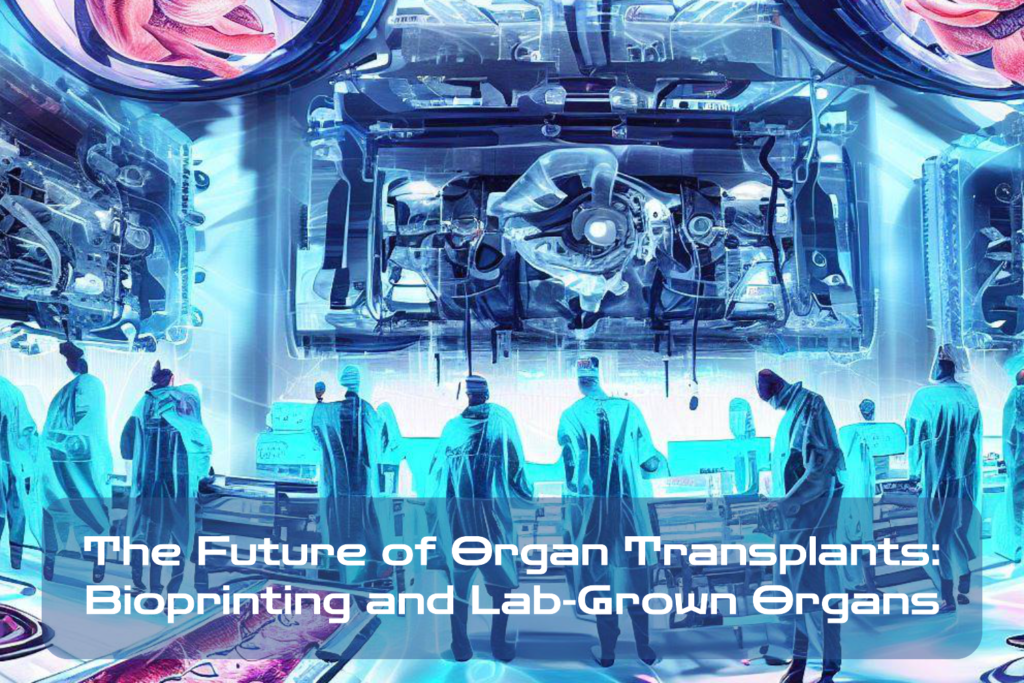NB.
Please forgive the lack of images in what is a thought-provoking introductory look at Bioprinting and Lab-Grown Organs, but the images … well, it seems I am feeling squeamish today…!
The field of organ transplantation has come a long way since the first successful kidney transplant in 1954. Since then, millions of people have received life-saving organ transplants, but the demand for organs continues to far exceed the supply.
According to the United Network for Organ Sharing (UNOS), there are currently over 103,575 people (at time of writing) on the waiting list for an organ transplant in the United States alone.
Organ transplantation presents many challenges and limitations, including donor shortages, tissue rejection, and prolonged waiting periods. However, recent advances in technology have given rise to new possibilities for addressing these challenges through bioprinting and lab-grown organs.
Brief history of organ transplants
Organ transplantation has been around for centuries, with references dating back to ancient Greece and Rome. However, it wasn’t until the 20th century that successful human organ transplants were achieved.
The first kidney transplant was performed in 1954 by Dr. Joseph Murray at Brigham and Women’s Hospital in Boston. Since then, medical professionals have made significant advancements in organ transplantation techniques and outcomes.
Heart, liver, lung, pancreas, and intestinal transplants are now relatively routine surgical procedures with high success rates. However, despite progress over the years, there remains a significant shortage of available donor organs, leading to long waiting lists for critically ill patients.
Current challenges and limitations in organ transplantation
While modern medicine has made great strides in organ transplantation procedures during last decades there are still significant challenges that prevent meeting the demand for organs needed by those who suffer from chronic or acute conditions that damage their own tissues or organs beyond repair.
One major challenge is donor availability; an insufficient number of donated organs means that many patients die while awaiting a suitable match.
In addition, the process of tissue rejection remains a significant hurdle in the transplantation process; it occurs when a recipient’s immune system recognizes the transplanted organ as “foreign” and attacks it. This can lead to organ failure and, ultimately, the loss of life.
There is a significant shortage of viable organs available for transplantation, leading to long waitlists and limited access to treatment for those in need. This is especially problematic for patients who require multiple transplants or who have rare blood types.
The potential of bioprinting and lab-grown organs
Bioprinting and lab-grown organs present promising solutions to these challenges in organ transplantation. Bioprinting technology allows medical professionals to precisely create complex 3D structures such as human tissue using bio-inks made from living cells and biomaterials.
Additionally, advances in stem cell research are making it possible to grow fully functional human organs outside of the body. These breakthroughs have the potential to revolutionize organ transplantation by overcoming donor shortages, reducing tissue rejection rates, and providing greater access to life-saving treatments.
Furthermore, they provide opportunities for more personalized medicine while also enabling researchers to explore new avenues for researching diseases that until now weren’t possible due to difficulty accessing human tissues.
The Revolutionary Technology of Bioprinting
The field of bioprinting has emerged as a promising solution to the challenges that currently exist in organ transplantation. Bioprinting is the process of creating three-dimensional (3D) structures by printing living cells layer by layer using specialized printers. This technology can be used to create structures such as tissues and organs, which can then be implanted into patients who require transplants.
One primary advantage of bioprinting is that it has the potential to overcome the problem of organ shortages.
With bioprinting, it will be possible to produce organs on demand, meaning that patients will not have to wait for a matching donor organ.
Another advantage of bioprinting is that it could potentially eliminate some of the risks associated with traditional transplantation methods.
For example, rejection is a common complication following a transplant procedure because patients’ immune systems often recognize the transplanted organ as foreign and attack it. Bioprinted organs can be produced using the patient’s own cells, which reduces this risk significantly.
Current Progress and Future Possibilities
While bioprinting technology is still in its early stages, significant progress has been made in recent years towards creating functional tissues and organs using this technique.
Researchers have already successfully printed heart valves, liver tissue, kidney tissue, and even entire small-scale human liver models using bioprinters. In addition to overcoming organ shortages and reducing rejection rates, there are many other exciting possibilities for future applications of bioprinting technology.
For example, scientists could use this technique to print personalized drug delivery systems or test new drugs on 3D-printed tissues before conducting clinical trials on humans.
Despite these exciting possibilities, there are still many challenges that need to be overcome before bioprinting can become a widely adopted technology for organ transplantation.
These include the need to improve the accuracy and resolution of bioprinters, optimize cell viability during the printing process, and ensure that the printed organs function properly once implanted into patients.
However, with continued research and development in this field, it is likely that bioprinting will play an increasingly important role in the future of organ transplantation.
Lab-Grown Organs
Explanation of lab-grown organs
Lab-grown organs, also known as artificial organs or bioengineered organs, are created in a laboratory using various techniques such as cellular reprogramming, tissue engineering, and 3D printing.
The process involves taking cells from the patient’s body or other sources and growing them on a scaffold. This scaffold acts as a framework for the cells to grow around and eventually form an organ that is capable of performing its intended function.
The goal of lab-grown organs is to provide a solution to the shortage of donor organs available for transplant. With over 100,000 people in the United States alone waiting for organ transplants, this technology has the potential to save countless lives and improve the quality of life for those suffering from chronic diseases.
Advantages over traditional transplantation methods
One of the main advantages of lab-grown organs is that they can be engineered specifically for each individual patient. This means that there is no need to worry about finding a compatible donor or dealing with issues such as rejection by the patient’s immune system.
Lab-grown organs can also be designed to have higher functionality than traditional transplanted organs, which may have been damaged or diseased prior to transplantation.
Another advantage is that lab-grown organs eliminate many of the ethical concerns surrounding organ donation.
As it stands today, many donor recipients are forced to wait years on end before they receive an organ transplant due to a lack of donors. By creating these artificial organs in labs, we can reduce this wait time significantly.
Current progress and future possibilities
Currently, scientists have successfully grown several types of lab-grown tissues and even smaller human-sized structures such as bladders and tracheas. However, there is still a long way to go before we can reliably grow whole complex organs such as hearts and lungs. In the future, lab-grown organs have the potential to revolutionize medicine.
With advances in technology, we may be able to grow fully functional human organs outside of the body that can be transplanted into patients without any worry of rejection or disease transmission. This technology could significantly reduce the burden on healthcare systems around the world by reducing wait times for organ transplants and eliminating many of the negative side effects associated with traditional transplantation methods.
Ethical Considerations
The development of bioprinting and lab-grown organs presents a host of ethical considerations.
One major concern is the potential for the technology to further widen the gap between those who can afford life-saving treatments and those who cannot. Bioprinting and lab-grown organs are likely to be expensive, which could leave many patients unable to access these treatments.
This would create a new form of inequality in healthcare that could have troubling implications for society.
Another ethical concern surrounding bioprinting and lab-grown organs is safety.
Because this technology is so new, there may be unforeseen risks associated with its use. Ensuring that bioprinted or lab-grown organs are safe for human use will require rigorous testing and evaluation, which can be time-consuming and expensive.
Addressing concerns about access to technology and affordability
To ensure that all patients have access to bioprinted or lab-grown organs, it will be important to address concerns about affordability. This may involve government subsidies or insurance coverage for these treatments, as well as efforts to drive down costs through increased efficiency in production processes.
Another important consideration is equity in access.
It will be essential to ensure that bioprinted or lab-grown organs are available to all patients who need them, regardless of their socioeconomic status or geographical location. This may require investment in infrastructure and delivery systems capable of providing these treatments on a widespread basis.
Ensuring safety and efficacy in the development process
Ensuring safety and efficacy in the development process will require careful regulation by government agencies such as the FDA. Regulatory bodies will need to establish clear standards for evaluating the safety of bioprinted or lab-grown organs before they can be used on humans.
In addition, it will be important for researchers working on this technology to conduct thorough testing at every stage of the development process. This will help to identify any potential safety risks or issues with efficacy before bioprinted or lab-grown organs are used in human patients.
Addressing concerns about access and affordability, as well as ensuring safety and efficacy through rigorous testing and regulation, will be key in realizing the full potential of these innovative treatments.
Potential Impact on Healthcare Industry
Revolutionizing Healthcare Costs
One of the most significant impacts of bioprinting and lab-grown organs in the healthcare industry is the potential to revolutionize healthcare costs. While traditional organ transplantation methods are expensive due to the need for donors, transportation, and medication, bioprinting and lab-grown organs can reduce costs significantly.
As these technologies continue to develop, it’s expected that they will become more affordable for patients. Moreover, because these methods use a patient’s own cells to create organs or tissues, there will be a decreased risk of rejection.
This means that patients may not need as many immunosuppressive drugs as they would with traditional transplantation methods. The reduced need for medication translates to lower overall healthcare costs.
Addressing Concerns About Job Displacement
As with any new technology, there are concerns about job displacement for healthcare professionals. In particular, surgeons who specialize in organ transplantation may fear losing their jobs if bioprinted or lab-grown organs become widely available. However, it’s important to note that these technologies won’t replace medical professionals entirely.
Surgeons will still be needed to implant bioprinted or lab-grown organs into patients’ bodies. Additionally, researchers and engineers will still be necessary to develop new techniques and improve upon existing ones.
The Potential For Increased Access To Life-Saving Treatments
The Revolutionizing Of Transplant Waiting Lists
Another significant impact of bioprinting and lab-grown organs is the potential for increased access to life-saving treatments. Bioprinting and lab-grown organs could dramatically reduce the waiting list, as organs and tissues could be produced on demand. This means that patients could receive life-saving treatments much faster than they would with traditional transplantation methods.
The Potential Elimination of Organ Shortages
Moreover, bioprinting and lab-grown organs have the potential to eliminate organ shortages altogether. Lab-grown organs can be created using a patient’s own cells, eliminating the need for donors altogether. This would mean that anyone in need of an organ transplant could receive one without having to wait for a donor match.
Final Thoughts
The future implications for organ transplantation are vast with advancements in bioprinting technologies that allow for 3D printing of functional human tissues such as skin cells up to heart valves. Bioprinting holds immense promise by allowing researchers to recreate not only biological structures but also anatomical models that they can simulate experiments on without risk to human life.
Lab-grown organs hold great potential due to their ability to be personalized which could lead to higher success rates during transplants while reducing rejection rates from the host body. Future implications include finding new ways to reduce wait times for patients needing organ transplants while increasing survival rates post-surgery.
We can see that bioprinting and lab-grown organs offer promising solutions that could revolutionize organ transplant procedures forever. Continued research is critical in this field because it will help us gain deeper insights into tissue engineering technologies that are still in their infancy. This research will eventually lead to a breakthrough that will enhance the quality and quantity of organs available for transplantation while reducing wait times and improving success rates post-surgery.
The potential impact of bioprinting and lab-grown organs on healthcare is immense, as accessibility to life-saving treatments increases with technological advancements. The future is bright for organ transplantation, and we can all look forward to a world where the need for organ donors decreases as bioprinting and lab-grown organs become more commonplace.

C M, a seasoned editor, journalist, and consultant, is deeply fascinated by the convergence of technology, space, and the future of humanity.
With a particular interest in transhumanism, futurology, and the philosophical and ethical dimensions of these domains, C M serves as the lead contributor to TranscendSphere and SpaceSpotlight.
When not penning insightful articles on these rapidly evolving fields, C M indulges in their love for podcasts and books, proudly embracing their status as a ‘Happy Nerd Extraordinaire!’





